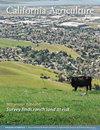Impacts of winter cover cropping on soil moisture and evapotranspiration in California's specialty crop fields may be minimal during winter months
IF 1.1
4区 农林科学
Q2 AGRICULTURE, MULTIDISCIPLINARY
引用次数: 6
Abstract
As fresh water supplies become more unreliable, variable and expensive, the water-related implications of sustainable agriculture practices such as cover cropping are drawing increasing attention from California's agricultural communities. However, the adoption of winter cover cropping remains limited among specialty crop growers who face uncertainty regarding the water use of this practice. To investigate how winter cover crops affect soil water and evapotranspiration on farm fields, we studied three systems that span climatic and farming conditions in California's Central Valley: processing tomato fields with cover crop, almond orchards with cover crop, and almond orchards with native vegetation. From 2016 to 2019, we collected soil moisture data (3 years of neutron hydroprobe and gravimetric tests at 10 field sites) and evapotranspiration measurements (2 years at two of 10 sites) in winter cover cropped and control (clean-cultivated, bare ground) plots during winter months. Generally, there were not significant differences in soil moisture between cover cropped and control fields throughout or at the end of the winter seasons, while evapo-transpirative losses due to winter cover crops were negligible relative to clean-cultivated soil. Our results suggest that winter cover crops in the Central Valley may break even in terms of actual consumptive water use. California growers of high-value specialty crops can likely adopt winter cover cropping without altering their irrigation plans and management practices.冬季覆盖种植对加利福尼亚特种作物田土壤水分和蒸散的影响在冬季可能很小
随着淡水供应变得越来越不可靠、多变和昂贵,覆盖种植等可持续农业实践对水的影响越来越受到加州农业社区的关注。然而,在特殊作物种植者中,冬季覆盖种植的采用仍然有限,他们面临着这种做法用水方面的不确定性。为了研究冬季覆盖作物对农田土壤水分和蒸散的影响,我们研究了加利福尼亚中央山谷三个跨越气候和耕作条件的系统:覆盖作物加工番茄田、覆盖作物加工杏仁园和原生植被加工杏仁园。从2016年到2019年,我们在冬季月份收集了冬季覆盖作物和对照(清洁开垦的裸地)地块的土壤水分数据(在10个站点进行了3年的中子水探针和重力测试)和蒸散量测量(在10个站点中的2个站点进行了2年)。总体而言,在整个冬季或冬季结束时,覆盖作物与对照地的土壤湿度没有显著差异,而由于冬季覆盖作物造成的蒸散损失相对于清洁耕作的土壤可以忽略不计。我们的研究结果表明,就实际耗水量而言,中央山谷的冬季覆盖作物可能会收支平衡。加州的高价值特种作物种植者可以在不改变灌溉计划和管理措施的情况下采用冬季覆盖种植。
本文章由计算机程序翻译,如有差异,请以英文原文为准。
求助全文
约1分钟内获得全文
求助全文
来源期刊

California Agriculture
农林科学-农业综合
CiteScore
2.40
自引率
7.70%
发文量
17
审稿时长
>12 weeks
期刊介绍:
Information not localized
 求助内容:
求助内容: 应助结果提醒方式:
应助结果提醒方式:


